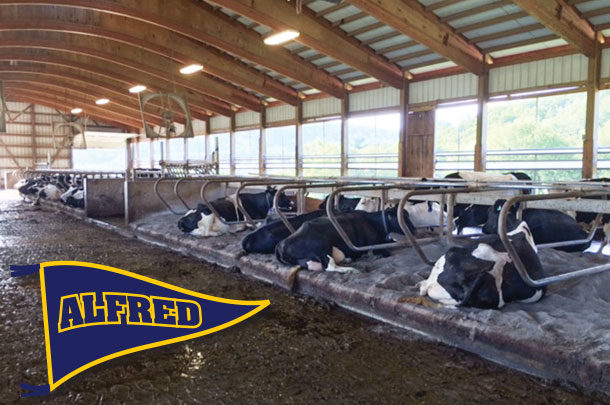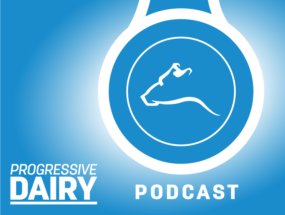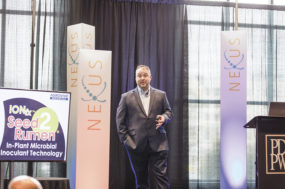With the school semester just around the corner, many universities across the U.S. put the finishing touches to recent university farm renovations this summer.
Backed by millions of dollars of federal and industry support, the renovations will help institutions develop the latest commercially available research and provide talented graduates to the dairy industry. The facility upgrades include university upgrades since 2013.
Alfred State College
Alfred State began its dairy program in 1908, with the last major farm upgrade occurring in 1964. In 2013, a $5 million project brought substantial improvements to the college dairy farm.
Before planning the building upgrades, a study group was set up to identify the future needs of the dairy faculty and the college farm. The group of professors, alumni and friends of the college found “sustainable” dairying as the key requirement of the future. Based on this finding, an organic herd was developed.
The college now runs an organic and a conventional confinement dairy herd side by side.
“We don’t promote either system,” says Philip Schroeder, chair of the agriculture department Alfred State. “We just teach the most sustainable practices for both systems.”
The organic dairy herd recently built a new 60-cow sand-bedded freestall barn complete with a robotic milking machine. The barn has excellent ventilation with curtain sides and a series of fans along the central passageway.
“It’s pretty much like a wind tunnel when it’s all closed up and the fans are on,” Schroeder says. A new 1,350-gallon bulk tank has also been installed.
The conventional herd upgrades have renovated the single-six parlor and installed new cleaning equipment. A second 1,350-gallon bulk tank with plate cooler has also been fitted. Water from the plate cooler recirculates to the water troughs. A condensing gas boiler and new LED lighting reduce the dairy’s energy use and improve sustainability.
Both herds will share a new heifer barn, hoop calf barn and hay shed.
Additional ongoing upgrades include classroom renovations and plans to build a new commodity shed and hay barn.
“Our building work has brought us up to modern standards. With our two dairy systems on the same farm, we offer a unique educational experience to our students,” Schroeder says.
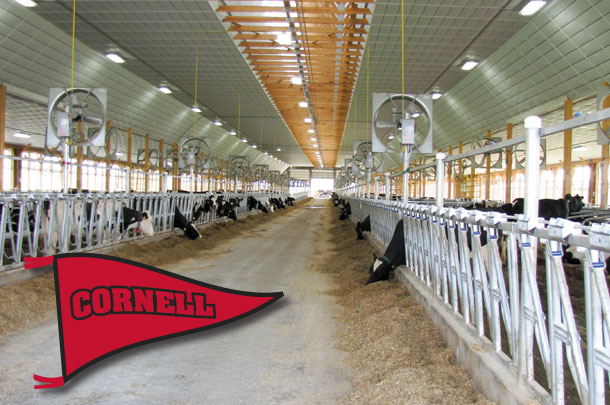
Cornell University
September 2013 saw the completion of Cornell University’s $7.1 million dairy farm upgrade. A new 500-cow freestall barn, double-16 parallel parlor, special-needs barn, 80-cow feed intake tiestall barn and 12-stall metabolism facility were built. These new buildings allowed cow numbers to increase by 75 cows to 575.
“We’ve seen a 15-pound increase in milk yield, too, since we moved into the new buildings,” says Tom Overton, associate professor with the college of agriculture and life sciences.
The original 1970s buildings, which included a 400-cow freestall barn, double-10 parlor and 126-cow tiestall, were inefficient and outdated for cow comfort, Overton says. The new facilities include features such as milk meters, evaporative cooling and curtain sides on the tiestall barn. A two-stage lagoon and vacuum truck is used to clean sand from the freestall barn.
“We also have the option to subdivide the barn into 12 pens of 16 cows for replication research,” he says. Special drover alleys allow each pen of cows to stay in their specific group as they travel to and from the parlor.
The main university farm, which is located 15 miles from campus, will be used mainly for research. On campus, a 150-cow sand-bedded freestall barn and double-10 parlor have also been built. These facilities will be used for teaching the veterinary and animal science students. The upgrades have not only boosted student life but also boosted employment in the area. Approximately 30 local staff have been hired to independently manage the main university farm.
“Two new dairy nutrition and dairy extension positions will also open up in the near future,” Overton says.
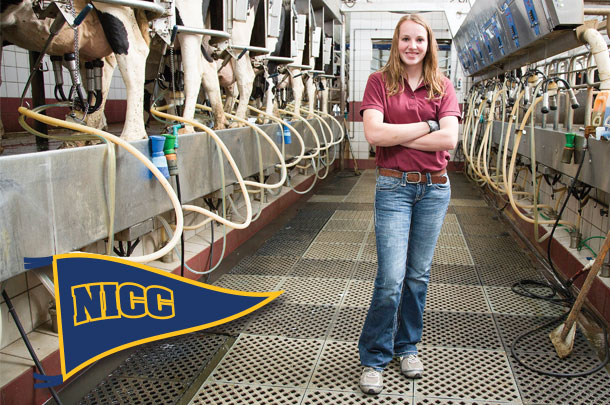
Northeast Iowa Community College
December 2013 saw the installation of two robotic milking machines at the Northeast Iowa Community College dairy. The robots milk 120 cows from the 300-cow herd. The remaining cows are milked through a double-eight parlor, with one side herringbone and one side parallel.
The three-row freestall barn, which contains one-third slatted floors and two-thirds alley scrapers, was also refurbished in 2013. The original mattress-topped stalls were converted to deep sand-bedded stalls. The dirty sand is currently being spread on the fields, but the option of cleaning and recycling sand is being considered for the future.
“Although we have some research work, we are mainly a teaching institution,” says Dave Lawstuen, chair of dairy operations at Northeast Iowa Community College. “The 2013 upgrades allow us to teach different dairy systems to our students.”
Future developments are focused on building a beef barn to raise bull calves from the dairy herd. The beef-sired bull calves will come from the low-genomic-merit cows. “The improved barn and robot system is not only used by our 200 agriculture students but also by our beef science and veterinary students,” Lawstuen says.
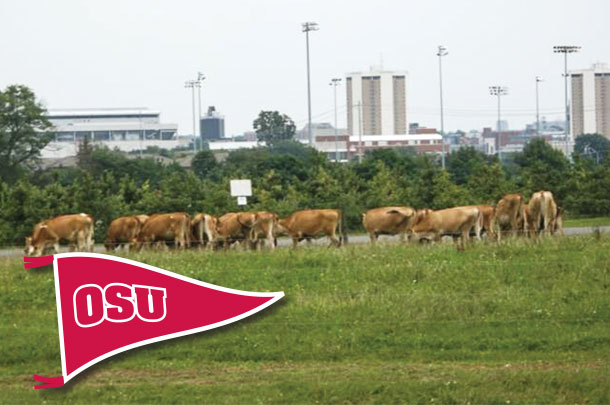
Ohio State University
During the 1970s, Ohio State University built a teaching dairy on campus and a separate research dairy located off-campus in Wooster. Both 110-cow dairies have been under gradual renovation for the past several years. The program focused on structural barn improvements.
“We built new concrete walls, replaced old timber support poles with concrete and improved the foundations and floors,” says Joseph Hogan, an Ohio State University animal science professor. The campus freestall and tiestall facilities were retrofitted to meet the now all-Jersey herd demands.
“Our old stalls were either too big for our Jerseys or too small for our Holsteins. We only milk Jerseys now, and the new stalls are built to fit,” Hogan says.
The campus dairy stalls are fitted with mattresses and bedded with minimal amounts of sawdust.
“Our manure goes into the city sewer system, so we’re limited to the bedding systems we can use,” Hogan says.
The research facility has removed several solid walls and installed new fans to improve ventilation and cow comfort. The entire area, including the stalls, alleyways and parlor, was fitted with rubber mats.
“The rubber surface has had a tremendous improvement to cow comfort and health. Our regular foot trimming schedule is now highlighting small problems before they develop into lameness,” Hogan says. The outdated mechanical alleyway scrapers were also replaced to clean the new rubber surface.
The feed storage facilities of both dairies also received improvements. A new feed bunker was built at Wooster, and a silage bag area was built at the campus dairy. These improvements have replaced the 13 upright silos previously used to store feed.
“The new feed areas offer more consistent feed storage, which is important for research trials. But more importantly, it’s a safer and more labor-friendly way to manage feed,” Hogan says.
The farm upgrades have been self-funded by the dairy’s own revenue. Hogan claims the dairy’s switch to an earnings account style of management was a key driver to increasing the available funding.
“The dairy is now run with profit in mind, and the staff have a real sense of ownership and pride now,” he says. “Although research work is not always as profit-driven and cost-effective as commercial dairying, the value of running a university farm as a business is huge.”
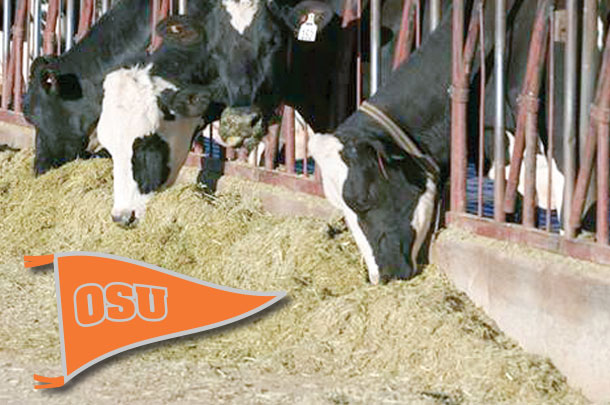
Oklahoma State University
Backed by a private dairy alumnus donation, Oklahoma State University has recently started the design process for a new dairy barn and student housing project.
The university dairy, located just a few miles from campus, was built during the 1960s. The dairy facilities include a drylot area, 120-cow freestall barn, double-six herringbone parlor and four bedrooms of student housing.
“The new facilities will allow us to teach our students dairy cow management in a modern environment,” says Sara Place, assistant animal science professor at Oklahoma State University.
Initial plans are being drawn up for a new four-row sand-bedded freestall barn and modern student accommodation. Four students will live on-farm, with a further 12 students employed at the dairy. The new barn will be fitted with the latest individual feed intake research equipment for use in nutrition trials.
“We’re excited about the new facilities; they will help our research and teaching work here at Oklahoma State,” Place says.
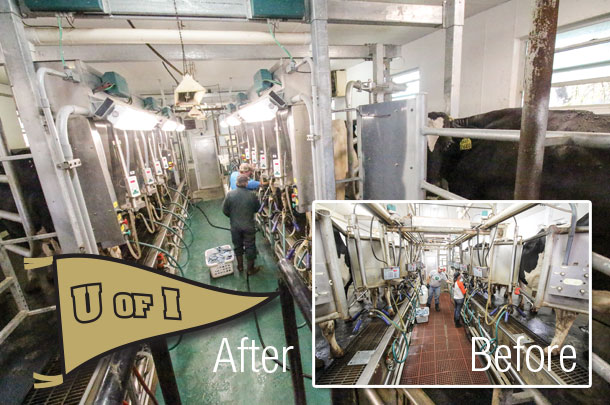
University of Idaho
Improvements to the University of Idaho’s dairy parlor were last carried out in the 1980s. The double-six parabone parlor, used to milk 105 cows, is currently receiving a full restoration. When completed later this fall, the parlor will contain new stalls, milk meters, auto cluster removal, milk lines and CIP systems. The project will also renovate the lighting, windows, wall coverings and paint work.
“We’ve also installed an auto ID system in the parlor, and we hope to update the herd to a full EID monitoring system in the future,” says Joshua Peak, University of Idaho dairy operations manager.
Peak hopes the new automated parlor will help grow the university’s research and extension work. “We’re mainly a teaching institute, but the future aim is to receive faculty funding for research projects,” Peak says.
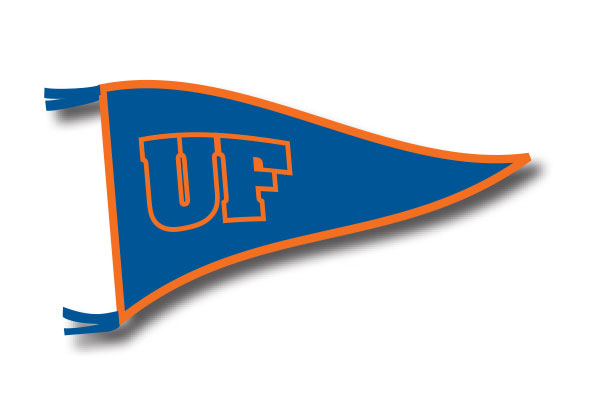
University of Florida
The dairy facility at University of Florida, used solely for research, has increased the size of its freestall and tiestall facilities in recent years. Previous to the upgrades, the 550-cow milking herd had access to 80 individual feeding freestall pens and a 30-cow drylot area.
The interior of two existing farm buildings were demolished and remodeled. The facility now has a capacity of 116 cow individual feeding freestall pens, a 32-cow drylot and a 10-cow intensive research tiestall area. Ventilation was improved throughout the open barn buildings.
“We installed new 56-inch fans over the stalls and feeding areas, and updated the 36-inch fans in the parlor holding area to 56-inch fans,” says José Santos, professor of animal science at the University of Florida.
Exit lane weigh scales were also installed in the parlor.
This summer, the improved facilities have been used to research prepartum cooling, Vitamin D use in transition cows and fatty acid intestinal flow and digestion.
This fall, automatic milk and grain feeders will be installed in the calf barn.
“Our individual calf hutches will be remodeled to group pens to fit the new feeders. This will allow us to start several calf research trials,” Santos says.
Development work will continue in the near future, with a new dry/transition cow barn currently in the design phase. Construction work is expected to begin next year.
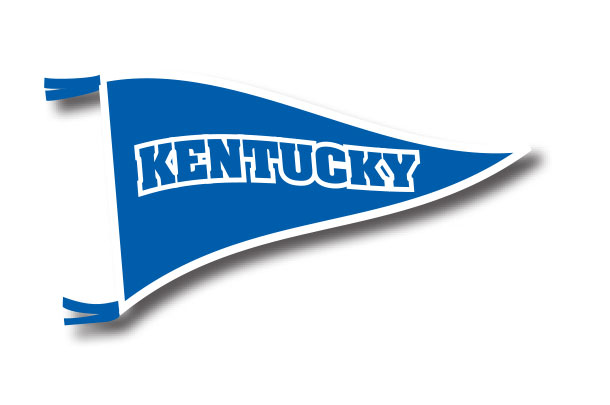
University of Kentucky
Steven Higgins, director of environmental compliance at the University of Kentucky, says the dairy farm upgrades have made the institution the “benchmark for environmentally sustainable dairying.”
“Our new facilities are showcasing the latest practical and environmentally conscious methods of dairying,” Higgins says. The environmentally focused project was funded through the Congress-backed EPA 319H grant system.
Dairymen, university representatives, EPA agents and water inspectors have visited the dairy in recent weeks to observe the new farm layout.
Kentucky dairymen using a liquid manure management system are subject to strict regulations as part of their nutrient management and water quality plans. Solid manure systems have less storage and application regulations.
“Our compost-bedded-pack barn and special drylot have excellent environmental standards, plus we’ve avoided the expense and inconvenience of liquid manure regulations,” Higgins says. “Clean water is kept clean, and solid manure is not contaminated with rainwater.”
The drylot acts as a feeding area and holding area in wet weather. The drylot construction began by removing the top 10 inches of topsoil. A non-woven geotextile membrane was laid down and covered with 8 to 10 inches of half-inch rock and dust.
“Once the rock is rolled, it gives a solid, smooth surface with good grip,” Higgins says.
The university’s old cow barn and concrete J-bunk feeding area has been renovated to a compost-bedded-pack barn and roofed alleyway with locking headgates for feeding. The concrete alleyway was grooved to provide a safer surface for cows.
The pasture area around the dairy has also been developed.
“The pasture work was inspired by Jerry Swisher’s 1990s scientific paper, which promoted the cow comfort and production benefits of pasture forage cover,” Higgins says.
The pasture has been re-grassed with fescue and divided into four paddocks. A 16-foot-wide lane links the pasture, drylot and barn together. Depending on weather conditions, cows can be held in any of these areas.
New water troughs have been installed in several locations to improve access to water. The trough size requirements are based on a formula of 1.2 inches per cow.
“So a trough circumference of 60 inches can water 50 cows,” Higgins explains.
Higgins says the compost-bedded-pack barn is one of the best ways for dairymen to manage cows and manure.
“Everything is contained in the one barn. There’s no expensive liquid or sand handling, and the cow comfort factor is huge,” Higgins says.
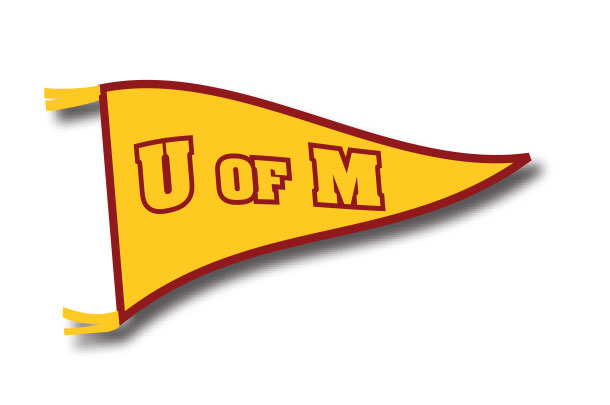
University of Minnesota
The University of Minnesota is currently finalizing a feasibility study to double its campus dairy herd to 240 cows.
“We are the only university dairy in the U.S. that’s situated in a city center of 3 million people, so we have to take certain precautions before we expand,” says Marcia Endres, dairy science professor at the University of Minnesota.
The farm’s 120 cows are housed in a sawdust-bedded tiestall barn. Within the past year, the farm has improved the use of technology in the existing farm buildings. Some of the improvements include a feed supervisor software program and a custom-made conveyor belt system.
“The conveyor belt is important for research using different diets, as it delivers individual diets to each cow; the mixer can only feed out one diet at a time,” Endres says.
The calving stalls have been made larger, and a new warming pen has been built for drying and feeding newborn calves in cold winter weather.
“We also installed a wireless camera system, which monitors the entire barn and maternity area,” Endres says. “Our staff and researchers can log in and view what’s happening on their cellphones.”
Other installations include new livestock scales, a hoof trimming chute and milk meters.
“The new technologies will improve farm productivity and provide good data to our students,” Endres says. Apart from educating the university students, the farm also hosts up to 30 school-tour visits each year to help educate the local urban youth on modern-day dairy farming.
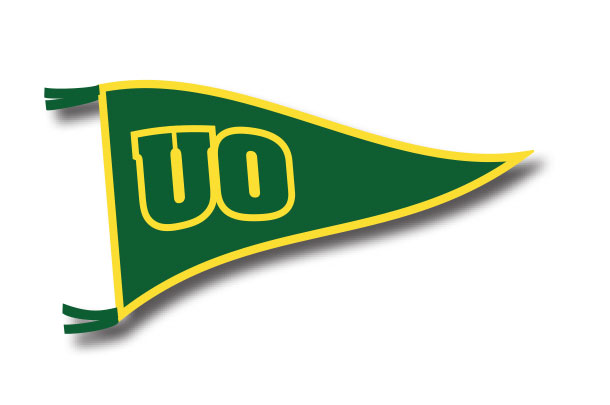
University of Oregon
In 2012, the University of Oregon sold its 70-cow dairy herd and closed the dairy farm. High costs of production, poor milk prices and, most importantly, inadequate liquid manure storage forced the closure. The farm reopened in late 2014 after investing in improved manure storage facilities.
“A million-gallon aboveground liquid manure tank has been built to store all waste from the dairy,” says Seth Spencer, farm superintendent at the University of Oregon. The old shallow lagoon had only four months’ storage capacity, which was unsuitable to accommodate the high volumes of rainfall in Oregon.
“Our new lagoon can store 12 months of manure, so we have no issues now,” Spencer says.
The herd has been re-established and has returned to the existing freestall barn and double-seven parlor. During the closed period, no farm teaching or research was carried out, as only a small number of heifers remained on-site. Since reopening, the farm has been available to student classes. An embryo transfer study has been completed, and plans are in place to carry out nutritional and manure management research this fall.
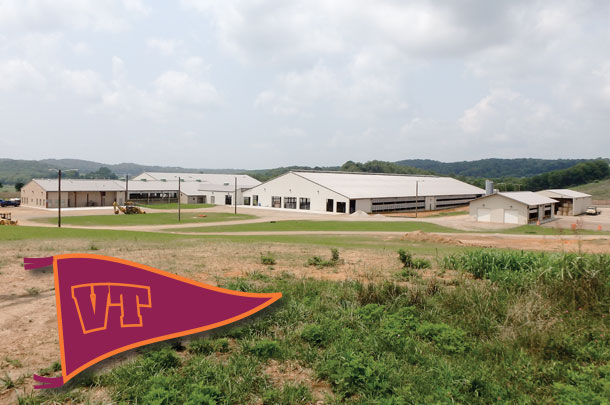
Virginia Tech University
This August, Virginia Tech will begin milking its 330-cow herd on a new dairy site.
The university dairy farm has moved 12 miles to an 1,800-acre university-owned farm. The previous dairy farm, which was located close to a highway and airport, will be converted to different university use.
A new freestall barn and double-12 parallel parlor were built on the new site. The parlor contains the latest auto ID, auto drafting, and activity and rumination monitors.
A robotic calf feeder has been installed in the new calf barn. New handling facilities comprised of a holding area, two chutes and a weigh scale are contained in the special-needs barn. Dairy students, vet students and postgraduate researchers will use the improved facilities.
“The new dairy will be more compact and efficient,” says Bob James, professor of nutrition and management. “We also have a small lab and diet mixing area in the barn, which will help our research projects.”
While the old farm used sawdust-bedded stalls, a new sand lane and solids separator have been built to manage the now sand-bedded stalls.
Phase two construction of the dairy will begin this fall. An intensive animal research facility will be built to carry out nutrition research.
“Forty individual Calan feeders will be installed, which will allow us to carry out accurate trials in the future like intake and amino acid trials,” James says. The data gathered from the calf feeder and parlor will greatly assist Virginia Tech in activity, behavior and mastitis research, James says.
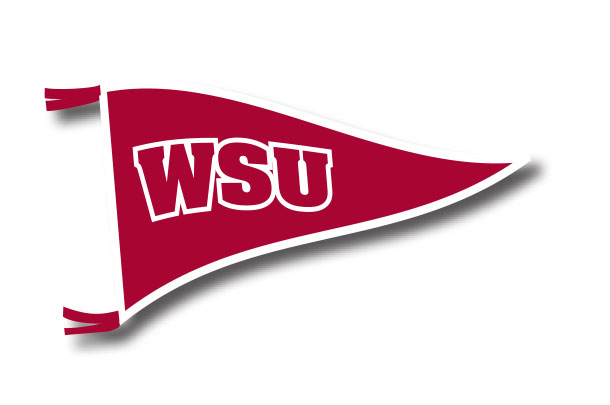
Washington State University
The planning process for WSU’s farm upgrade began three years ago. The farm’s double-five herringbone parlor has been refitted and extended to a double-six herringbone to milk 180 cows. Cows are currently on twice-daily milking for a nutrition trial but will move to three times a day after they complete the trial.
The new parlor contains an air-cooled vacuum pump, rubber floor mats, automated cluster removal, milk meters, auto ID and milk conductivity testing.
“When we input all this information into our farm software, we have a wealth of information for teaching our students and for our monthly DHI tests,” says John Swain, WSU farm manager.
The farm’s nutrient management systems are also being upgraded this year. A new table-press manure separator will increase removal of solid manure from the farm lagoon.
“We currently run a scrape-and-separate system, but we aim to eliminate our smaller lagoon so that we use less water,” Swain explains.
WSU’s new faculty staff member, Amber Adams, will make use of the new dairy facilities for her research and extension work.
“The recent WSU dairy facility upgrades were necessary to ensure our data is representative and meaningful for dairy producers,” Adams says.
The data collected is being used for antibiotic resistance, cryptosporidium and ventilation research. Adams is also heavily involved in animal behavior research, which she says is becoming a more essential part of farm management.
“When our cows experience less stress and normal behavior, they are healthier and produce more milk,” Adams says.
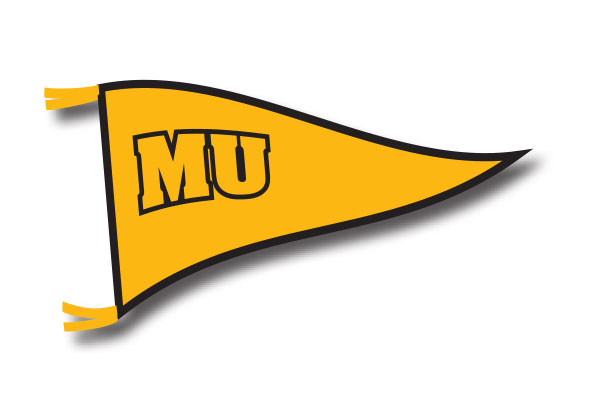
University of Missouri
The University of Missouri veterinary faculty completed a full metalwork refurbishment of its animal handling facilities in 2013.
“We needed to refurbish our metalwork, as it was simply wearing away,” says John Middleton, assistant director with the college of veterinary medicine. After an outbreak of salmonella in 2005, the handling facilities had been regularly disinfected with Virkon disinfectant, which is extremely aggressive on metal. “Virkon eats everything, so we will only use it when we have a confirmed case of salmonella in the future,” Middleton explains.
The facility’s 12 stalls, animal handling area, squeeze chute, rotating shank chute and calf table have all been replaced. Additional safety features such as escape ladders in the alleyways have also been installed.
“We handle everything from lambs to rodeo bulls, so sometimes you need to get out of an animal’s way,” Middleton says. The majority of the new facility is galvanized, while some of the curved surfaces of the Temple Grandin-inspired animal handling area are made of stainless steel.
Further upgrades are currently in the planning process. A $3.9 million office, garage and teaching building will be constructed in the near future. Funding is expected to come from the veterinary faculty and an annual $1 million food animal education and research state grant.
While the veterinary facility is used to treat sick cows from the 200-cow university farm, it also serves as a commercial veterinary practice. The practice handles 25,000 animals each year, both in the field and in the practice. The majority of customers are beef herds, with dairy, sheep and goat producers also serviced.
“The Missouri Dairy Revitalization Act should bring investment to the local dairy sector, so we hope to grow that area of our veterinary service,” Middleton says.
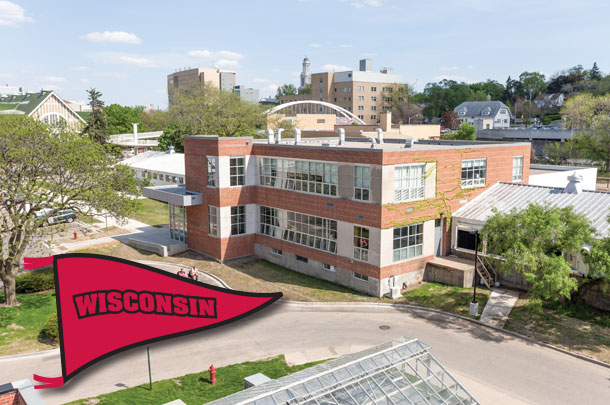
University of Wisconsin – Madison
The University of Wisconsin – Madison operates three dairy farms in Madison and nearby Arlington and Marshfield. Over the past nine years, the farms have seen gradual improvements, including a complete overhaul to the Madison farm in 2013. A new double-six parlor and 80-cow tiestall barn with improved ventilation was built.
Further plans to renovate classrooms and build a new visitors’ center are scheduled for this fall.
“The students are the main beneficiaries of these varied facilities,” says Dr. Kent Weigel, department of dairy science professor and chair. More than 200 students use the Madison campus dairy each day. Undergraduate and postgraduate researchers also enjoy using the excellent facilities on all three farms. Current research projects involve hypoglycemia, ketosis, lameness and stall surface comfort using cold-water waterbeds.
“We developed the double-Ovsynch program here, and we aim to bring more commercially available research to dairymen in the near future,” Weigel says. PD
Michael Cox was a 2015 Progressive Dairyman editorial intern.
PHOTO 1: Alfred State researches both conventional and organic production systems with two herds. Photo provided by Philip Schroeder.
PHOTO 2: Facility upgrades at Cornell allowed the herd to increase by 500 cows. Photo provided by Tom Overton.
PHOTO 3: Robots and a parlor allow students to see a variety of milking systems. Photo provided by Doug Ropa.
PHOTO 4: Facility upgrades at Ohio State included stalls sized to fit the all-Jersey herd. Photo provided by Joe Hogan.
PHOTO 5: Plans at Oklahoma State include individual feed intake research equipment. Photo provided by Sara Place.
PHOTO 6: Updates in the parlor at University of Idaho include an auto ID system, with plans to upgrade to a full EID monitoring system in the future. Photos provided by Bill Loftus.
PHOTO 7: The new facility at Virginia Tech includes a new freestall barn and double-12 parallel parlor. Photo provided by Bob James.
PHOTO 8: Plans for upgrades at UW-Madison include classroom renovations and a new visitors’ center. Photo provided by Ted Halbach.
